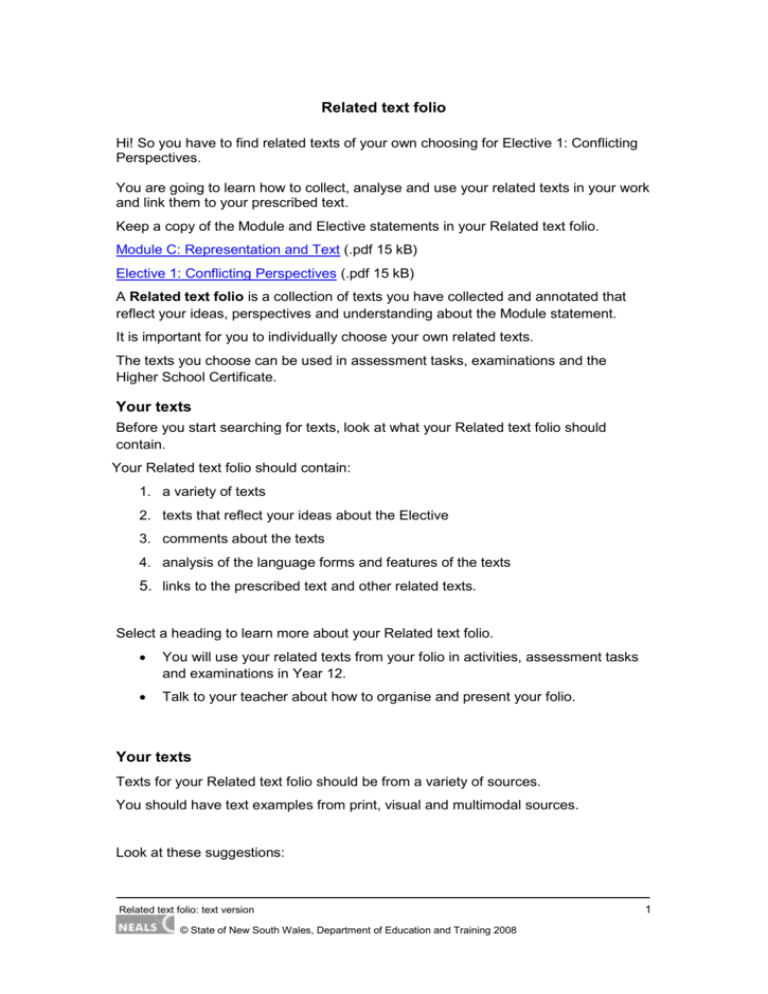Related text folio - Department of Education NSW
advertisement

Related text folio Hi! So you have to find related texts of your own choosing for Elective 1: Conflicting Perspectives. You are going to learn how to collect, analyse and use your related texts in your work and link them to your prescribed text. Keep a copy of the Module and Elective statements in your Related text folio. Module C: Representation and Text (.pdf 15 kB) Elective 1: Conflicting Perspectives (.pdf 15 kB) A Related text folio is a collection of texts you have collected and annotated that reflect your ideas, perspectives and understanding about the Module statement. It is important for you to individually choose your own related texts. The texts you choose can be used in assessment tasks, examinations and the Higher School Certificate. Your texts Before you start searching for texts, look at what your Related text folio should contain. Your Related text folio should contain: 1. a variety of texts 2. texts that reflect your ideas about the Elective 3. comments about the texts 4. analysis of the language forms and features of the texts 5. links to the prescribed text and other related texts. Select a heading to learn more about your Related text folio. You will use your related texts from your folio in activities, assessment tasks and examinations in Year 12. Talk to your teacher about how to organise and present your folio. Your texts Texts for your Related text folio should be from a variety of sources. You should have text examples from print, visual and multimodal sources. Look at these suggestions: Related text folio: text version © State of New South Wales, Department of Education and Training 2008 1 novels short stories poems song lyrics plays nonfiction multimedia products films documentaries websites essays feature articles The texts must be substantial. Choose texts that interest you and that you can access. Select texts that reflect your thinking about representation. Collecting Use four or five key aspects from your study of the Elective to help you focus your search. Where to look for texts: 1. Use the library to begin your search. Use your topic headings to focus on information in reference books, novels, poems, nonfiction works 2. Use the TV guide to source relevant shows, documentaries and movies. Keep a viewing journal to record your viewing and use it to analyse relevant texts. 3. Use the internet but remember to consider who produced the site, reliability and appropriate materials. 4. Use the print news media to find articles, newspaper and magazine stories. Try to collect up-to-date texts from a variety of sources. Don't leave it to the last minute to get your texts organised and analysed. Keep searching and collecting texts about the module during Year 12. Recording As you search for texts, don't forget to write down information about where they came from. For each text you need to write down: full name of the text author or composer where the text came from: newspaper, radio show, magazine, pamphlet, internet Related text folio: text version © State of New South Wales, Department of Education and Training 2008 2 type of text: TV program, documentary film, feature article date of publication, viewing or accessing the website. Look at these examples for recording text details: Title: Terror@Home Composer: Director, Shariff Latrobe Type of text: TV documentary Source: BBC Channel 4 Date: February 2006 Title: Dreams from My Father Type of text: Autobiography Composer: Barack Obama Date: 1997 Don't forget to label each related text and include your responses to the worksheet in your folio. Keep a list of the websites you access in your searches. Analysing After you have found your texts, you need to analyse and write some information about each text and link them to your ideas about the Elective. Use the Related text folio worksheet to help you analyse your texts. Related text worksheet (.pdf 34 kB) Look at the examples of analysis of a related text: Example 1: Adbusters (website) (.pdf 36 kB) Example 2: Thank You for Smoking (film) (.pdf 21 kB) Keep your responses to the worksheets in your folio with the text. For TV shows and films you can write a detailed review and include it in your folio. Linking As you collect and analyse your texts don't forget to link your ideas about the Elective to your prescribed text and other related texts. Draw a table (.pdf 17 kB) to help you link your ideas, your texts and the texts you are studying in class. You can use the headings below: representation Related text folio: text version © State of New South Wales, Department of Education and Training 2008 3 events personalities situations morality ethics. Don't forget to link the language features and techniques in the texts you are studying. Tasks In exams and assessment tasks you will be asked to use your prescribed text and one or more of your related texts in a response about the Elective. English (Advanced) Paper 2 Modules In the HSC English examination Paper 2, you are required to compose an integrated response to the Electives question. In your answer you must link your ideas about representation and meaning to your prescribed text and texts of your own choosing. Look at the sample questions for Elective 1: Conflicting Perspectives. Sample questions (.pdf 17 kB) Extended response scaffold (.pdf 46 kB) Make sure you read the dot points about what you will be marked on before you begin your response. For help with writing extended responses read the examination reports for past HSC papers at the Board of Studies website. Related text folio: text version © State of New South Wales, Department of Education and Training 2008 4







